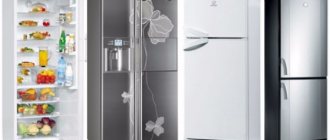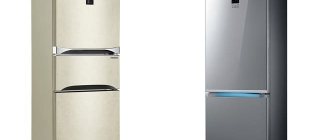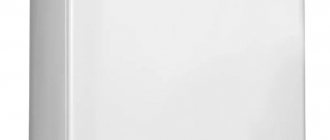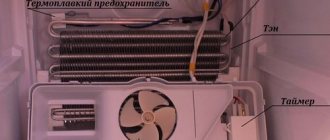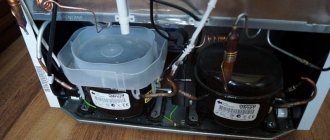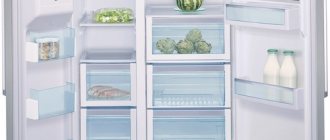Modern refrigerators have one of two automatic defrosting systems: drip and No Frost, which means “without frost.” Each of them has its own advantages and disadvantages. Let's figure it out: know frost or drip refrigerator: which is better in order to make the right choice when purchasing.
Difference between drip and No Frost refrigerator
Among people who are not very well versed in refrigeration technology, there is an opinion that the drip system is much worse than No Frost. That in such refrigerators the ice freezes at a terrible speed and that they need to be defrosted very often. Actually this is not true. Most modern refrigerators have high-quality insulation of the chambers; the doors fit tightly to the body thanks to multi-circuit seals. Therefore, almost no ice is formed inside with any of these systems.
We can briefly imagine the advantages of each of them.
| Drip | No Frost |
| Cheaper | Less hassle with care |
| More useful volume | Recovers temperature faster after defrosting |
| Consumes less energy | The cold spreads evenly throughout the chamber |
| Works quietly | Quick freezing |
| More models available | No condensation on the back wall |
What choice should you make in the end?
The no-frost system is designed to facilitate the maintenance of refrigeration equipment. The device maintains a uniform temperature regime, making the defrosting procedure faster. After a long break in operation, the refrigerator quickly gains temperature. If you choose between two types of systems, the buyer will choose the model that completely suits him personally. The drip system is inferior in some ways to No Frost, and superior in others. When choosing an economical option, you need to choose a drip system. If functionality and practicality come first, then a system with know frost would be a good option.
Drip system
The drip defrosting system is the most common. It consists of the following main components:
- Engine with compressor
- A condenser in the form of a coil through which the refrigerant moves
- Capillary tube - the place where gas turns into liquid
- An evaporator located inside the housing that cools the chambers
- Temperature control relay
All these parts are hidden behind a plastic casing, so they are not visible in the camera and do not take up extra space.
Operating principle of a refrigerator with a drip system
In refrigerators with a drip cooling system, moisture collects on the back wall, from where it gradually flows into a special container. Under the influence of the evaporator, droplets are removed from the chamber.
It goes like this:
- When operating, the compressor increases the pressure of the refrigerant gas
- The gas enters the capillary tube and condenses, turning into a liquid there
- It enters the evaporator and takes heat from the chamber
- When heated, the refrigerant boils and turns into a gaseous state.
Let's see what's happening in the cell at this time. The moisture is distributed evenly there. When the compressor turns on and starts to cool the back wall, it collects on it and turns into frost. When the compressor stops, having created the required pressure, the frost begins to thaw. The water runs down through the drainage hole into a container located above the compressor. When it heats up, the moisture evaporates out.
Drip refrigerator
The evaporator in such a device is located in the area of the rear wall, where moisture condenses. After the compressor is turned off, the liquid begins to melt. It moves along a special chute and accumulates in a small container, where it evaporates. The drip refrigerator has a number of positive and negative qualities.
Advantages of drip refrigerators
- The main advantage is the preservation of a large amount of moisture in products. This makes it possible to store them without the use of special packaging.
- Low cost.
- A large number of different models when compared with non-freezing refrigerators.
- The device operates almost silently, since there is no fan.
- Consumes minimal electricity.
- Refrigerating chambers have a large capacity.
Cons of drip refrigerators
- Cooling is not very intense. After opening the door, the temperature recovery occurs very slowly.
- A wet wall remains on the back surface. Products should not touch it. They may get wet or freeze to the surface.
Important! When the refrigerator is in working condition, it is strictly forbidden to wash its back wall. It is necessary to avoid the use of detergents that contain abrasive particles. Metal jaws are not permitted.
- About once every six months, the refrigerator has to be stopped. A “fur coat” appears in the freezer, which needs to be gotten rid of.
- The refrigerator compartment is not uniform in temperature. The value of the lower area may differ from the upper area by several degrees.
- Sometimes the gutter designed to drain condensate becomes clogged. It needs to be cleaned constantly. If this is not done, accumulated water will fall into the bottom of the device.
Refrigerators with No Frost system
The No Frost defrosting system is more prestigious than drip defrosting. Its essence is that the moisture accelerated by the fan does not have time to turn into frost or ice in the chamber. It is brought out through a system of passages in the rear and side walls. There is an evaporator, a built-in heating element and a drainage system through which moisture passes.
The principle of operation of a refrigerator with a No Frost system
The refrigerant is compressed to a liquid state under the influence of a compressor and begins to absorb heat. Fans distribute cold air throughout the chamber and the system of passages in the walls. As a result, the temperature in the center and all corners is equalized, the products are cooled or frozen evenly. Moisture in the air leaves the wall and condenses on the evaporator coil.
After a certain time, the heating element starts. Under its influence, the ice thaws and water flows through the drainage system into a container on the compressor. It evaporates out. Therefore, the chamber walls always remain dry.
Advantages
The No Frost system has the following advantages:
- Ice and frost do not form in the chamber, so it can not be defrosted for several years. But manufacturers recommend doing this at least once a year for hygiene purposes.
- The walls of the chamber are always dry
- Bacteria do not collect inside due to normal humidity levels
- Uniform temperature is maintained in all corners of the chamber
Flaws
No Frost also has disadvantages:
- The system has more units, so the likelihood of breakdown increases
- Repairs are more expensive than for a drip system
- Products can only be stored in closed containers. When open, they quickly ventilate due to the regular inclusion of the fan.
- Fans make additional noise. This is especially true for budget models
- Noise level 36-47 dB
Which system is better
It is possible to determine which system is more suitable only by assessing the conditions under which the unit will be operated, as well as for what purpose it will be used to a greater extent. To understand the features of each system and their differences, it is recommended to use a comparative characteristic:
- Defrosting system. Both types do not require the participation of the owner and manual work. But No Frost is considered more practical. Also, such a system allows you to get rid of moisture unnoticed by the user’s eyes;
- Service. The drip type in some cases requires cleaning the drainage hole. His opponent can get by without much service;
- Cold distribution. With No Frost, the temperature is distributed evenly across all chambers. The drip system is characterized by temperature differences in different places of the unit;
- Fast temperature recovery. The drip type has medium speed. But if there is a power outage, it will maintain a low temperature longer. The No Frost system has a high recovery rate. But if you deprive it of food, the cold will quickly disappear;
- Humidity inside the equipment. No Frost allows you to reduce humidity levels to a minimum. It's practically absent inside the cells. The opponent has a moderate level of humidity. Condensation forms on the back wall, so moisture will be present even in working equipment;
- Noise during operation. Both units operate almost silently;
- Energy consumption. No Frost may consume more energy due to the greater number of energy-consuming elements in the unit;
- Refrigerator volume. There is more useful space that can be used in the drip type. This is due to the absence of some parts that are equipped with units with No Frost and take up additional space.
- Price. Drip models are cheaper than those equipped with the No Frost system.
The main differences, advantages and disadvantages, as well as comparative characteristics of each system were noted. It is recommended to rely on this information when choosing suitable equipment.
No Frost is a more innovative, modern type of unit in terms of ease of use and efficiency. There is no need to waste time on manual defrosting and removing ice yourself. But you will have to pay a hefty price.
The choice of household appliances should be made depending on needs, ease of use and material capabilities.
The drip system is considered more reliable. It has been on the market longer and has managed to prove itself on the positive side. In the event of a breakdown, you will have to pay less for its repair than if your opponent has a breakdown. But the drip type requires periodic independent defrosting, and condensation during evaporation is noticeable on the back wall.
No Frost: myths and reality
A couple of decades ago, refrigerators with a No Frost defrosting system were much more progressive. Then the drip system could not ensure tightness inside the chambers due to the fact that the doors did not close tightly. Things look a little different now.
Unpleasant odors and rapid drying of food
Unpleasant odors do not form in a freezer equipped with a No Frost system, unless emergency defrosting occurs. In the refrigerator they can occur for the same reason or during storage of spoiled food. But the chances of this happening are less than with drip, because air exchange occurs faster and the temperature is equalized.
This type of refrigerator does not have a drain hole, so it cannot become clogged and cause unpleasant odors. Products in the refrigerator with No Frost quickly air out if stored uncovered. If you hide them in a container, there won't be much difference.
No Frost does not require defrosting at all
According to user stories, some of them do not defrost their refrigerator for 5-6 years. But it's not right. For the system to work properly, you need to remove food from it at least once a year, wash and wipe all surfaces.
Dry refrigerator is hazardous to health
From time to time, there are conversations on the Internet that the No Frost refrigerator is dangerous to health. This refers to the use of harmful substances as a refrigerant. Previously, outdated appliances used chlorofluorocarbon, which everyone knows as freon. After it was recognized as dangerous for the ozone layer, the cooling systems of refrigerators began to be filled with the inert gas tetrafluorocarbon R134a. Now many modern models use R600a.
The refrigerator, like any electrical appliance, including mobile phones, emits electromagnetic waves. But in modern devices they are tens of times less than in representatives of the last century. Just in case, it is better to install such a refrigerator at a distance of 1.5 m from the living area, and drip ones - 0.5 m. Since the refrigerator is rarely placed in the bedroom, it does not pose a significant danger.
There are no No Frosts with large chambers
Chambers with No Frost lose a lot of space due to additional equipment and air passages separated by a panel. In a chamber with a volume of 350 liters, only 300 liters will be useful. To get a large freezer, you need to buy a Side-by-Side refrigerator. The volume of chambers in the middle price class is 170-190 liters. Manufacturers Samsung, LIEBHERR, LG produce refrigerators with freezers from 260 to 290 liters.
No Frost system refrigerators are very noisy
It is believed that refrigerators with a No Frost defrosting system make more noise than appliances with a drip system. This occurs due to the fact that they use one or more fans that disperse air throughout the chamber.
Comparison of refrigerator defrosting systems
As you can see, both systems allow refrigerators to operate uninterruptedly and save their owners from regularly removing all products and waiting 10-15 hours to remove a thick layer of ice. It is not difficult to notice that the first type is a little simpler, and the second more complex, but which is better - a No Frost refrigerator or a drip refrigerator - you can understand if you compare these systems with each other.
It is important to consider that refrigerator designs may vary. For example, a model may have a drip defrosting system in the main chamber (refrigerator) and a No Frost system in the freezer.
The most advanced option is No Frost in both chambers, with separate temperature control in each. But whether it will be better for you, decide based on the following comparison.
Defrosting
Neither the drip type nor the No Frost require defrosting. Both options can work for a year or more, performing their functions well. There have been cases when such models were not disconnected from the network for up to 5 years. Automatic thawing of frozen moisture and its removal are provided for by the design of both devices.
Therefore, from a functionality point of view, they are the same, but in terms of practicality, No Frost is better, since water flowing down the back wall can confuse the eyes of an uninitiated person or fall on leaning products. This comparison concerns the refrigerator compartment.
Freezers are not of the drip type, due to the need to constantly maintain negative temperatures there. Therefore, here No Frost is clearly superior to refrigerator models that have a refrigerator compartment with a drip defrosting system, and a freezer with manual defrosting.
Although the build-up of frost in their freezer is not as obvious as it was with Soviet units, they will have to be defrosted once every 6 months. If you buy a refrigerator with a drip system in the main chamber and No Frost in the freezer, then this problem disappears by itself.
Refrigerator with a drip system in the refrigerator compartment and a No Frost system in the freezer.
Service
The operating instructions provide for washing the internal surfaces at least once a year, or even more often. Otherwise, droplets of spilled liquid, juice from overripe fruits and the aroma of cooked garlic cutlets will be absorbed into the plastic and give a characteristic smell to the household appliance. And since for washing it is necessary to get all the products, both units are turned off from the network and there is no better option here.
Among the disadvantages of the drip system in terms of maintenance, the only situation that occurs is when the drainage tube is clogged. This can happen due to plaque or trapped food particles. In this case, the water flowing down the back wall does not go into the reservoir on the compressor, but onto the floor of the refrigerator compartment.
It is easy to remove the blockage using a special device that comes with the refrigerator or a small rod of wire. If there is still ice there, you can pour warm water (about 100 ml) to improve permeability.
Cleaning the refrigerator drain hole.
In No Frost models, the collection and removal of moisture occurs behind the chamber, so nothing foreign gets in there, but they have more parts included in the device (one or more fans, their motors, additional heating of channels for removing water). Therefore, there is more to break.
So, cleaning the drainage is not difficult, but No Frost is much more expensive to repair. We noted this nuance for ourselves and move on.
Even distribution of cold
In this regard, No Frost is the clear leader. Thanks to the operation of the fans, cold air is evenly distributed throughout the chamber. The difference between the upper and lower sections can be 1-2 degrees, while for drip refrigerators this figure reaches 4-6 degrees (the closer to the freezer, the colder). Therefore, if perishable products are mistakenly placed on the wrong shelf, then without Know Frost they may spoil.
Regarding the distribution of cold, there are other differences in the drip refrigerator and No Frost, which are more noticeable during operation. Since in the first, the rear wall of the evaporator faces the refrigerating chamber, not only droplets of water, but also food can freeze on it.
Thus, a leaning bag of apples will get frostbite if the fruit touches the panel. This is dangerous for sensitive fruits and vegetables (strawberries, raspberries, tomatoes, cherries). This will never happen in models with No Frost.
The back wall of the refrigerator with a drip defrosting system.
Speed of temperature recovery
After holding the refrigerator door open for a long time or opening it frequently, the temperature inside rises. The same happens when a large batch of room temperature products is loaded. The rate of recovery -2...-6 degrees required for proper preservation of food depends on the power of the refrigerator and the quality of its thermal insulation, which affects heat loss.
But here No Frost still copes faster by starting the circulation of air masses, which quickly cool down in contact with the evaporator.
However, if there is a power outage, refrigerators with a drip system will last longer autonomously and maintain a low temperature in the chambers. This is possible due to the direct outlet of the evaporator to the products and the absence of air passage channels through which the cold escapes.
Humidity level in chambers
Since water flows down the wall of the refrigerator in drip systems, it evaporates a little back into the air, so it remains moderately humid. In No Frost, the fans constantly drive the air flow and, after contact with the evaporator, it no longer returns moisture back to the chamber.
Here the air is more dry. But this affects the change in the quality of products only when they are stored without containers, since without packaging, fresh greens will lose their beautiful appearance within a day in both devices. If you use storage containers, the products will be equally juicy.
In refrigerators with a No Frost system, food must be stored in containers.
Noise during operation
In refrigerators with a drip defrosting system, only the compressor runs periodically. During periods of inactivity, complete silence reigns. In No Frost, in addition to the compressor, there is also a fan. There may be not one fan, but several, so there is more noise from it.
In numbers it looks like this: drip - 40-42 dB, No Frost - 45-47 dB. To remedy the situation, some manufacturers have developed a specially shaped fan impeller that makes less noise when rotating. But there are not many such models. The clear leader here is the drip refrigerator.
Electricity consumption
It is generally accepted that No Frost refrigerators consume more electricity than other models. This is due to the need for power not only for the compressor, but also for the fan motors, as well as the heating element. In reality, it all depends on the specific refrigerator model, its power, the number of compressors and their type.
Thus, a refrigerator with No Frost and one inverter-type compressor (operates without switching off, but with different frequencies) will be much more economical than a two-compressor refrigerator with a drip system.
Useful volume of the refrigerator
The internal volume intended to accommodate food depends on the external dimensions of the refrigerator. Part of this space is spent on insulation materials, shelves, partitions and drawers. As a result, for a drip refrigerator with a total volume of 360 liters, the useful capacity will be 330 liters.
No Frost, with a total figure of 354 liters, will have a useful volume of 302 liters. Where did so much space go? It is occupied by additional equipment and is fenced off by a panel behind which there are channels for air passage.
Here, the clear leader is refrigerators with a drip defrosting system, which allow, with the same external dimensions, to be loaded with a large amount of food.
Refrigerator cost
Due to their more complex design and additional elements, No Frost refrigerators are more expensive. For example, a model with a volume of 300 liters for two chambers and drip technology from a well-known brand will cost 25,000 rubles, and the same one, but with No Frost, will cost about 40,000 rubles. Wanting to save on purchases, choose the first type.
Brief comparison of refrigerator defrosting systems
| Refrigerator with drip defrosting system | Refrigerator with No Frost defrosting system | |||||||
| Defrosting | does not require user intervention, but is less practical | does not require user participation, but is more practical | ||||||
| Service | The drain hole may need to be cleaned | No maintenance required during normal operation | ||||||
| Cold distribution | not uniform | uniform | ||||||
| Speed of temperature recovery | average, but during a power outage the cold stays longer | high, but during a power outage…. | ||||||
| Chamber humidity level | moderately humid | very low | ||||||
| Noise during operation | 40-42 dB | 45-47 dB | ||||||
| Electricity consumption | below | higher | ||||||
| Useful volume of the refrigerator | more | less | ||||||
| Refrigerator cost | less | higher | ||||||
Having compared various refrigerator defrosting systems, we see that each has its own pros and cons. Therefore, the choice of household appliances should be made depending on needs, ease of use and material capabilities. Perhaps the average option in terms of functionality and price would be a refrigerator with a drip system and a No Frost freezer.
If you notice an error, a non-working video or link, please select a piece of text and press Ctrl+Enter .
0
Tips for choosing
Having compared the two automatic defrosting systems, we see that they both have their advantages and some disadvantages. Therefore, each buyer chooses a refrigerator for himself, taking into account his needs and other parameters: cost, size, minimum temperature in the freezer.
For many, a good option would be a device with a drip system installed in the refrigerator compartment and a No Frost system in the freezer. It will be cheaper than Full No Frost, but this will not affect functionality.
Low Frost technology
Now let's look at another defrosting system in the refrigerator - “Low frost” and find out what it is. Let’s say right away that it differs from “know frost”. This technology appeared relatively recently, it is less than 15 years old. It was developed by the German company Bosch, which successfully uses it in its modern refrigerators.
Over time, “low frost” appeared in models from other manufacturers (AEG, Siemens, Gorenje).
The essence of Low Frost:
- the evaporator circuit is located along the entire outer perimeter of the chamber;
- this results in more uniform cooling and temperature distribution;
- minimal ice formation (from practice, in the form of a very thin ice coating on the walls and shelves);
- very fast defrosting and easy defrosting;
- Applies only to freezer compartments.
As you can see, a Low Frost refrigerator with freezer also needs to be defrosted, but quite rarely. For example, Bosch recommends defrosting once a year.
That is, as in the case of No frost, in fact, defrosting such a chamber is necessary primarily for sanitary reasons. If you handle your freezer very carefully (or don’t use it at all), then you can defrost it once every 5 years.
Differences between Drip and No Frost
Currently, the market offers the widest range of refrigerators of both types; the choice is complicated by a number of other characteristics: the number of chambers, compressors, and the presence of other additional options.
But when choosing the type of defrosting, the following indicators should be compared together:
- price;
- ease of care;
- energy consumption class;
- noise level;
- volume inside the refrigerator;
- quality of food preservation.
These indicators are exactly what distinguishes you when choosing between a drip refrigerator and a No Frost refrigerator.


